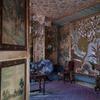Zisha Teapots Lead Chinese Ceramics at Gianguan Auctions
- NEW YORK, New York
- /
- August 30, 2013
When Gianguan Auctions opens its doors on its Sunday, September 15 sale, collectors will be bidding on a remarkable array of properties. Among them is an unusual single-owner collection of ancestoral Zisha teapots.
Zisha teapots are among the most beloved of teapots for several reasons. The clay itself - indigenous to Yixing in the coastal province of Jiangsu - often has a purplish cast. Chemically, its composition is such that when it is fired at temperatures as high as 2,200 degrees Fahrenheit, the clay remains porous where other types of clay would not. This unique characteristic allows the teapots to take on the flavor of tea within. No wonder Zisha clay is deemed a Chinese national treasure and the raw material is banned from export.
China's potters long ago discovered the secrets of molding Zisha into vessels that are both highly artistic and practical. Zisha teapots have been prized since the 17th C. They inspired not only the Kangxi emperor and 17th C. potters such as Shi Dabin but also recent collectors who have driven the auction price of Zisha teapots well above US $1 million. Pre-sale estimates of the five Zisha pots - Lots 224 to 226 - run from $300,000 to $1 million.
The most dramatic of the pots is an undulating dragon-form teapot in the shape of a tree stump. It is divided into four sections, each of which is a pot in and of itself. Toegther, the creation is a study in naturalism. Overall, the pots look like gnarled branches. They curve to form handles and are paired with vines and plum blossoms to form spouts. Tightly fitted lids look like stumpy knobs. A dragon’s head with open mouth and protruded tongue is worked into the first section. The two-character Jiang Rong maker's mark is impressed on the body of each section
Yet another teapot, also of highly organic form, takes its cue from both forest and zodiac animals, with twelve depicted. The pot bears the Chen Mingyuan mark along with a reign mark for the Imperial Palace.
Otherz Zisha teapots include one in the form of a mask, another in a 3-tier pagoda and yet another with animals on a fisherman's basket. For details, please visit the Gianguan Auctions website.
Other outstanding highlights are carved jades from the collection of 19th C. Governor Liu Yunke (1792 - 1864) of Zhejiang. Lot 187 is a set of nine Qing Dynasty jade carvings inscribed with excerpts form the Thirty-Six Art of War Strategy. The set includes a Bi bearing the Liu Yunke (He Qiao) collector seal, a notched Bi, a halberd blade, a pendant, a Zhang blade, three plaques, and a Ge blade. Lot 188 is a massive jade Bi in nine sections. Of translucent celadon coloration with russet inclusions, the center disc is formed by two half-spherical sections embellished with a pierced central medallion. The outer bi is comprised of nine sections. On the obverse, inscriptions are carved in clerical script, from the Book of Han. The reverse bears both Zhuànshū and Taotie masks.
Another is Lot 190, a 15-page gilt copper-sheet album of the Pratyutpanna Sutra (Composing of the Mind) Vol. 3. Nine hundred forty-five characters are inscribed in clerical script on gilt sheets. Held together by hinges, the volume is housed in a rectangular box on which the image of Maitreya is carved.
Lot 180, a Qing Dynasty carved jade brush pot with a reticulated floral and dragon design. The pierced cylindrical sides, 4 ¾ inches high, offer a continuous scene of two striding dragons amidst densely layered foliage and spray that creates a 3-D effect. The rim and base are incised with a classic scroll. Of translucent jade with touches of russet at the base, the brush pot is expected to command much high-level interest.
Another homage to the Deities is Lot 248, gilt statues of the Four Heavenly Kings, Stepping on the Evils of Human Nature. Each gilded Lokapala wears festooned armor and bejeweled head dress and holds a symbol appropriate to its role. The statues are Tang Dynasty and of the period.
Although these highlights are the top level marquee items, the auction is broad and includes decorative and antique properties in all price ranges. Among the ever popular Chinese ceramics are rare-form ritual items such as Lot 277, a tall, square Geyo Cong vase with horizontal ribs converging at the central vertical plane. It is covered with a crackled rust-brown white glaze, and is of the Song Dynasty. Lot 280 offers a vase of undulating melon shaped form. Standing in contrast to both is Lot 278, a bulbous celadon Longquan vase. With looped handles and dish mouth, the body is supported by bands of upright lappets and carved lotus floral pattern. Of the Northern Song Dynasty, the Longquan is expected to fetch $10,000 - $15,000.
For the complete line-up of Gianguan Auctions Fall Asia Week in NY sale on Sunday, September 15, please visit www.gianguanauctions.com
Contact:
Mary Ann LumG
212-226-2660
info@gianguanauctions.com
295 Madison Avenue
New York, New York
info@gianguanauctions.com
2128667288
http://gianguanauctions.com
















